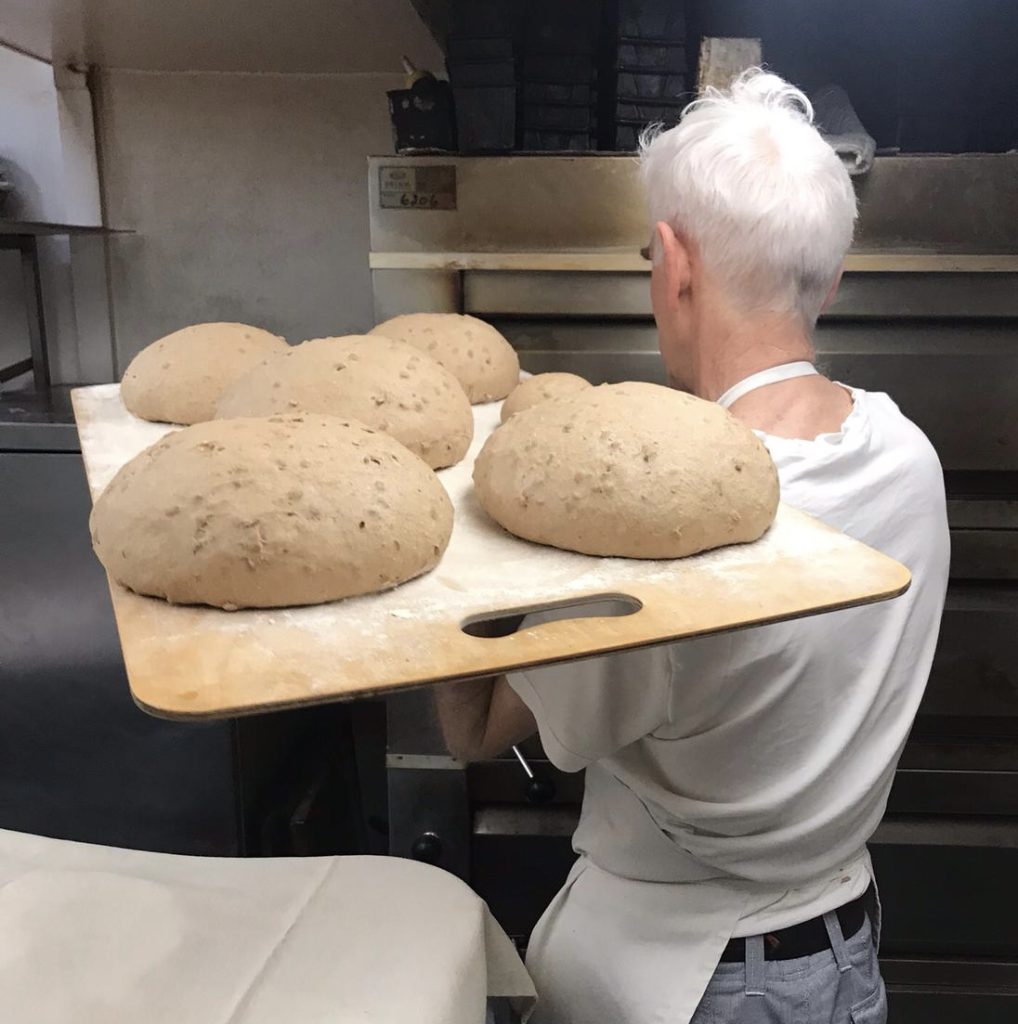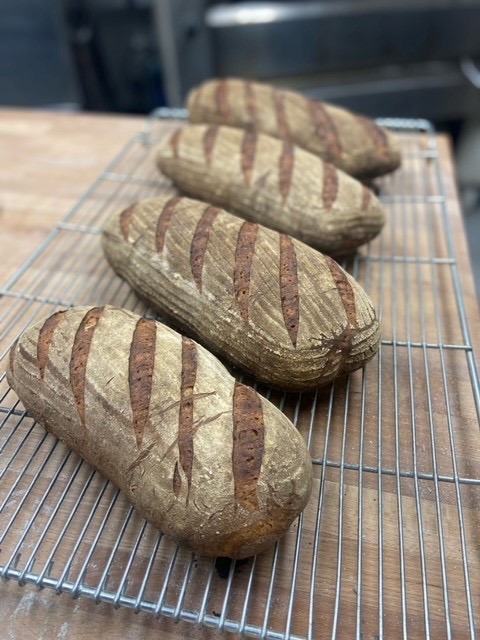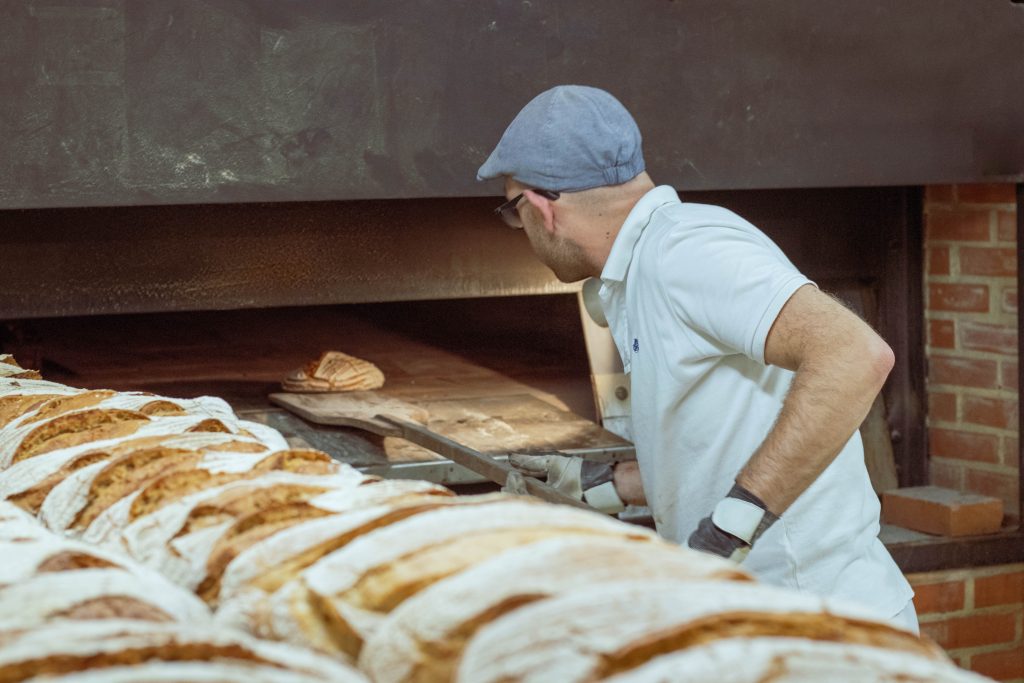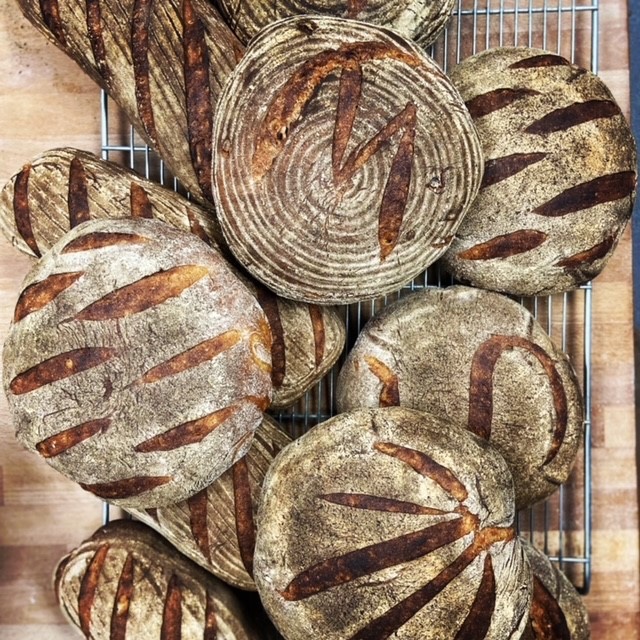
In my first blog piece I looked at my route to becoming a craft baker which was driven by my regard for crafts and the valuable culture of the people who work in them. After fifty years in bakeries I’m now writing a book devoted to the craft of baking and its history. This has led me to think about working in the craft today. Even though we are more conscious of sustainability some people would still regard any craft as anachronistic. However, increasing numbers of people decry the cost and wastefulness of packaging, transport, and warehousing, and believe it is a more sensible and happier life to organise the means of production and exchange at a more local level. Here I must warn you that those who want high salaries and riches should not choose make their living though a craft!
Working with one’s hands brings many levels of satisfaction and self-esteem. Imagine the smug pleasure derived from the task of cutting a dough sprawled across the table when one after another you weigh several pieces in a row that are the perfect weight, no need for any fiddly adjustment. Imagine those rare days when, as you lock up at the end of the day, you can honestly congratulate yourself that everything that came out of the oven today was of your highest standard. I feel fortunate to have earned my living plying a craft that for many people is fun, a hobby.

In my early days in England it shocked me how often I heard the old bakers I mixed with introduce themselves as “just a baker”. However this description would not have always been the case for bakers. In mediaeval times bakers were highly regarded. They had an influential Guild and their business was not only baking the bread but getting the wheat from the farmer or the middleman at a good price and arranging for its milling. In France village bakers were regarded highly not only for providing the staff of life, but also for being important citizens at a civic level as part of the village or town council.
Craft, artisanal, hand-made – we see these words everywhere describing all sorts of bread. The problem with these words is that they are not just descriptive but can be seen as conceptual, and many people see them as aspirational. In the advertising world and particularly that part of it serving industrial baking, the need for catch phrases is a powerful force for debasing language and broadening the appeal of certain phrases to a point where they tip over into meaninglessness. One of the first casualties I noticed was “home-made”. It can even be seen on the side of lorries delivering industrially made foodstuffs.
The misuse of another word “fresh” is particularly galling to real bakers. Factory-made dough is formed into loaves, frozen, placed in cardboard boxes, then delivered still frozen to a shop where it is thawed and baked off under the banner of “fresh bread sold here”.
In the corporate world of bread, two similar casualties have been “craft” and, more recently, ‘artisan’. Craft had an image that was a sitting duck, ready to be borrowed and debased. The term became a staple in advertising and bandied about to such a degree by huge firms that it has become utterly meaningless.
So what do we call ourselves? It is indeed a difficult task to pin down a useful definition of both these words. ‘Artisan’ originally from Latin, but borrowed from modern French, is uncomfortably linked to the arts and conjures up a sense of achieving artistry in the pursuit of an art form. It would be an odd baker nowadays who considered himself or herself an artist, although that baker’s contented customers might extol the artistry of the product and its maker. The definition of the ‘craftsman’ (though an inappropriate description today) is easier to accommodate since all crafts are also thought of as “handicrafts”, and dictionary definitions refer to the crafted object being hand-made. This reference to the hands is the main pointer to what I think of as craftsmanship.
In any traditional craft the practitioner is capable of the efficient repetition of a range of hand skills to produce the crafted object consistently. I think consistency is important and can be under-rated in an age when artistry and individualism are prized. In a pottery the ‘master potter’ will sternly point out to the apprentice that a group of six or eight mugs – to be sold as a set all bearing the same glaze – must all share the same height and width, and decoration. Similarly, an apprentice baker moulding half a dozen bloomers at the end of a batch of white bread must make them all roughly of the same length and girth and pay attention to slash them all in a similar decoration. Repetition, sheer practice, eventually enables the trainee to be able to churn out the crafted object with flair and consistency, and in the trade of baking a degree of speed is also necessary when you need to earn your living.

In my first blog piece I talked about how my interest in commercial baking began in the nineteen seventies. By then it was already difficult to find in Britain a baker worthy of the craft. Industrial practice, “instant” dough (meaning chemically assisted dough that is hurried to the oven without being given actual fermentation time in bulk), reliance on machinery – all these changes had undermined the craft to a point that it was an endangered species.
My reaction to the debasement of everything that rightfully belonged to the craft, was to use the word “artisan” to refer to a baker or firm that was still actively engaged with the craft of fermentation. Although by the nineteen nineties they were still a tiny sector, the artisanal bakers could recognise each other easily, and still do today. An initiative, spearheaded by Dan Lepard (baker, writer, and consultant) to create a trade group called the British Association of Artisan Bakers. It was hard to get off the ground, hard working artisan bakers who are doing long hours in a demanding small business never seem to have spare time to devote to travelling to meetings! I wanted it to succeed and offered my administrative services. During the few meetings that were held in the mid-nineties it was challenging, and exciting at the same time, to find a suitable definition of the craft practitioner/artisan for the group to be able to identify those worthy to be its members. The charge of élitism reared its head during rowdy circuitous discussions that were trying to find the code of practice that made a practitioner/artisan. Was the trade baker who used chemical “improvers” in his bread to be banned when he still weighed and worked dough by hand on a wooden bench with the obvious skills of the craft?
While we had failed to create an Association back in the nineties, a more recent group has had success – the Real Bread Campaign. It took inspiration from the impact of CAMRA (the Campaign for Real Ale) the body that evolved to save English ale. Like bread, real ale had become endangered, and there can be no doubt that CAMRA saved its bacon. Like CAMRA did for beer, The Real Bread Campaign has spawned many micro-bakeries and it has united those craft bakers who avoid chemical additives. Good bread needs only flour, water, yeast, and salt. Many of its members are sourdough bakers, extolling the virtues of wild yeast and with strict edicts about what constitutes ‘real bread’.
The craft baker can be forgiven for wanting some machines to speed up the process and boost the output capable of being produced by one session of work. The judicious use of machines will also save the baker from exhaustion. Imagine starting each day in the bakery having to hand knead two hundred kilograms of dough in two or three batches. I have met craft bakers who claim that machines are bad for dough since they are bruising and insensitive to the importance of creating dough with carefully developed gluten within what is recognised to be good dough structure for the resultant bread. Perhaps some of these people even see machines as going against their perception of the “spiritual” nature of making wholesome food – in this case bread dough – with love and care. Whatever they think, they need to look after their backs: one of the non-machine bakers I knew was obviously exhausted by what he was doing and probably thought I was being flippant when I urged him to get a machine for dough-making. A year later I saw he was in chronic trouble with a painfully bad back.

However, reliance on machinery must have its limits. Otherwise, the baker might as well be in a factory without even touching the dough or looking closely at it. There are some light industrial bakers (meaning they are small factories, not vast bread plants) who clamour to be included in the ranks of craftsmen or artisans since they are proud of their products. To me the test is simple: generally, do they pause to look closely at the dough and touch it? If they are simply machine minders governed by the clock they cannot be thought of as craft bakers since they are not making judgement along the way about whether the dough is ready or not to go on to the next stage. Surely, at several key points, exercising that judgment about the state, feel, and attributes of the dough is a necessary skill in the craft toolbox.
Having established that craft must involve the repetitive use of the hands and a sound knowledge of the materials being wrought into the product, the next issue is observation. Honing this skill is helped by repetition and practice so that it eventually becomes second nature. Doing and seeing something thousands of times means that its form is implanted in the sub-conscious, so that on the occasion when it is not looking right it will stand out immediately.
In my forthcoming book I will be exploring both the cultural history of bread, baking and sometimes bakers and their relationship with the social and geographical environment in which they ply their craft. I will also be getting into the practicalities of making bread, the ‘how to’ which I can pass on after years of practice and nagging from students who have attended my courses to put it in a book!

